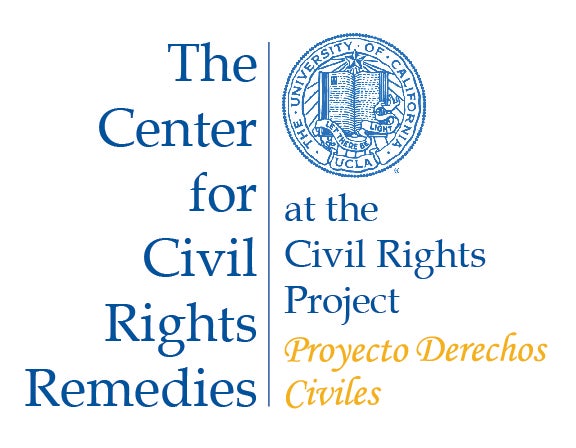LOS ANGELES – A groundbreaking research study released today shows that the overuse of harsh school discipline practices is not only harming student achievement, but also is costing taxpayers billions of dollars.
“The High Cost of Harsh Discipline and Its Disparate Impact,” released today by the UCLA Center for Civil Rights Remedies at UCLA’s Civil Rights Project, is the first to quantify the economic cost of suspending students from school. It builds on a large body of research demonstrating that excessive school suspensions fail to improve school learning environments or enhance academic achievement.
“Being suspended increases risk for dropping out of high school. That is a well-established fact,” said Dr. Russell W. Rumberger, co-author of the study and professor of education in the Gevirtz Graduate School of Education at the University of California, Santa Barbara. “People without a high school diploma earn less, have more health problems, and are more likely to get into trouble with the law. That means less tax revenue and higher health care and criminal justice costs for all of us,” Rumberger added.
“Not only will school districts increase graduation rates and generate billions of dollars in economic activity if they stop suspending so many students, the research also shows that reducing the racial discipline gap makes good economic sense and will reduce social costs that hit communities of color the hardest,” added Daniel J. Losen, director of the Center for Civil Rights Remedies at UCLA. “Schools don’t need to rely on suspension. There are many alternatives that teach good behavior and hold students accountable for their conduct while keeping them in school,” Losen said.
Using national longitudinal data that tracked a cohort of 10th graders, the researchers estimated that 10th grade school suspensions result in more than 67,000 additional high school dropouts nationally.
Using different data sources, the study also estimated the costs and effects of school suspensions in California and Florida, reaching remarkably consistent conclusions. According to the study, California 10th grade suspensions resulted in more than 10,000 additional high school dropouts. In Florida 9th grade suspensions increased the number of dropouts by nearly 3,500.
The study uses estimates of the economic losses from high school dropouts from Clive Belfield of Queens College. These estimates show that over the course of a lifetime, each additional dropout is responsible for $163,000 in lost tax revenue and $364,000 in other social costs, such as health care and criminal justice expenses. Cumulatively, the total cost of the 67,000 additional dropouts caused by school suspensions nationally exceeds $35 billion.
“$35 billion seems like a huge number, but it’s actually a very conservative estimate. We looked at data from just one cohort of 10th grade students. Multiply that with 10th grade cohorts from additional years and costs will easily exceed $100 billion,” said Losen.
“The High Cost of Harsh Discipline and Its Disparate Impact,” joins other studies in observing a strong race-based discipline gap, in which students of color are far more likely to be suspended than are White students. Reducing this discipline gap would not only promote equity and fairness, but also produce a strong fiscal return. The study noted that black students made up 13 percent of all 10th graders, but 25 percent of all suspended students. Black students represented 25 percent, or nearly $9 billion, of the $35 billion in economic losses due to suspensions.
Citing examples from states and school districts across the nation, the study’s authors explain that sharp reductions in suspension are an achievable goal. California, for example, has reduced suspensions by nearly 40 percent since the 2011-2012 academic year by virtually eliminating suspensions for the minor infraction of “disruption or defiance” and by taking other measures to promote alternatives to suspension. Richmond County, Georgia, has reduced suspensions even further. Some individual schools have reduced suspensions by more than 90 percent after introducing alternative discipline models.
Cutting suspension rates by 50 percent for just one cohort of students would result in economic savings of $3.1 billion for California and $817 million for Florida, according to the study.
The authors encourage education reformers to consider the real cost of suspensions, as states submit new accountability plans under the federal Every Student Succeeds Act. ESSA suggests designating school climate one of the accountability factors and requires all states to review district data and address the overuse of suspensions. States that actively pursue this federal requirement and reduce suspensions most aggressively will reap the greatest economic benefits.
The study offers three core recommendations for policymakers, including California school district leaders currently working to finalize their budgets and develop Local Control Accountability Plans to comply with the state’s new Local Control Funding Formula.
- Include suspension rates as a key metric when evaluating school performance. Given the clear link between suspension rates and graduation rates, fewer suspensions should be considered an indicator of school success. The California Board of Education recently supported this approach by including suspension rates as part of the state’s Local Control Funding Formula evaluation rubric and accountability system.
- Review and collect suspension data. In order to identify the most effective school discipline approaches, schools and districts should collect and report information about suspension and expulsion, not only in total, but also disaggregated by race, disability status, gender, and other categories.
- Direct resources toward effective discipline practices that keep children in school. The study demonstrates that investments in alternatives to suspension will pay for themselves many times over. However, that initial investment is needed to implement alternative practices and ensure that teachers and administrators are trained in their use.
